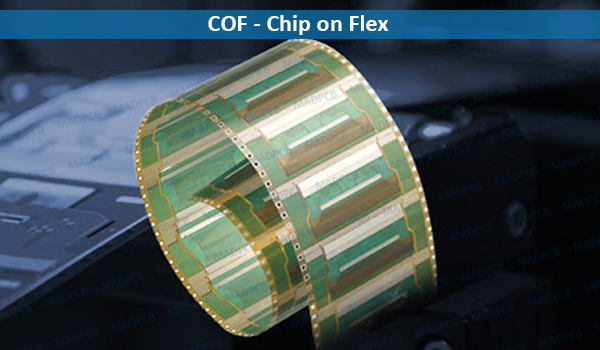What’s COF?
COF (Chip on Flex) is a display packaging technology, and is also a variation of COB, where a chip is mounted directly to a flex circuit. Unlike COB, it may not use wires nor be covered with epoxy, using underfill instead.
Chip-on-Flex refers to the semiconductor assembly technology wherein the microchip or die is directly mounted on and electrically connected to a flexible circuit (a circuit built on a flexible substrate instead of the usual printed circuit board). Thus, in a COF assembly, the microchip doesn’t have to go through all the traditional assembly steps required for individual IC packaging. This simplifies the over-all process of designing and manufacturing the final product while improving its performance as a result of the shorter interconnection paths.
The general term for COF technology is ‘direct chip attachment‘, or DCA. Aside from the flexible circuit substrates used for COF’s, various substrates are available for use in DCA. DCA assemblies are often named based on the substrates used, e.g., chip-on-glass (COG) for glass ceramic substrates, chip-on-board (COB) for PCB, chip-on-flex (COF) for flex substrates, etc.
Advantages of COF Technology
- Space savings
- Reduced weight
- Lower production cost
- Thermal durability and higher reliability from better heat distribution
- Shorter time-to-market; and of course
- Geometrical and mechanical flexibility
Because of its high bending strength, COF is very useful in device assembly processes that require bending or folding steps. It is also used in assemblies that require repeated movements such as printers.
As in most DCA technologies, COF assembly has only 3 main steps:
- Die attach, or the accurate attachment of the chip to the flexible substrate.
- Wire bonding, or the electrical connection of the chip to the flex circuit using very fine bonding wires.
- Encapsulation of the chip and wires with a special compound to protect them from the environment.
The chip is attached to the flex substrate using adhesives that can either be conducting or insulating, depending on the device requirement. Aside from providing mechanical stability and electrical conduction (or insulation) to the chip, these dies attach adhesives also provide thermal paths by which the heat generated by the device during operation can be released more efficiently.
Wires used for wire bonding COF assemblies are most often either aluminum or gold alloys. The diameter of these wires typically ranges from 22 to 25μm and should not be less than 15μm. The traditional ultrasonic and thermosonic wire bonding techniques used in IC packaging are also applicable to COF wire bonding. See Wire bonding.
The compound used in encapsulating the chip on flex to protect it from environmental factors is an epoxy resin whose viscosity, coefficient of thermal expansion, and amount of dispensation are determined by the characteristics of the flexible substrate and the COF itself.

